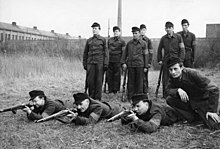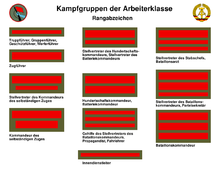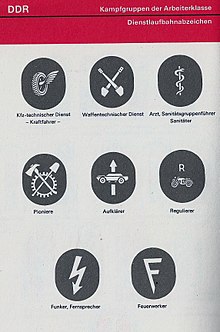Working class combat groups
|
Working class combat groups |
|
|---|---|
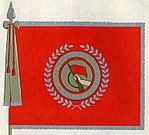 Combat group unit flag |
|
| active | 1953 to December 14, 1989 |
| Country |
|
| Armed forces | army |
| Type | Paramilitary |
| Strength | 210,000 (1980) |
| Insinuation | Ministry of the Interior |
| march | March of the combat groups |
The Combat Groups of the Working Class , also fighting groups (KG) or operating combat groups called were a paramilitary organization of workers in enterprises of the German Democratic Republic (GDR). Through it, the rule of the proletariat in the GDR should also be manifested militarily.
Membership organization
The members of this military unit were "members of the fighting groups of the working class". The fighters were mostly male members and a few women from the state-owned enterprises (VEB), state institutions, agricultural production cooperatives (LPG) as well as universities and technical schools, which in their free time several times a year (mostly on Fridays or weekends) for military exercises and training moved out in uniform. Approx. 60% of the fighters were members of the SED . In their vow, the fighters were sworn in: “As a working class fighter, I am ready to follow the party's instructions to protect the German Democratic Republic, its socialist achievements with gun in hand at all times and to give my life for them. I promise. ”Commanding functions were reserved for SED members. Membership in the combat groups was a form of voluntary military service for the protection of the fatherland, in addition to exercising a civilian profession and outside the National People's Army (NVA) and the border troops of the GDR .
The minimum age of the fighters was 25 years.
Double memberships in the Society for Sport and Technology (GST) and the DRK of the GDR were exceptions, in the civil defense of the GDR they were forbidden to avoid double allegations. The fighters were not allowed to belong to Reserve I of the NVA and they were not allowed to admit unserved employees who were still of conscription age. This was monitored by the military district commands of the NVA. Except in the pedagogical colleges , no combat group units were formed in the educational institutions of popular education. To this end, the teachers were advised to work as trainers within the GST in the pre-military training of pupils, apprentices or students.
In recognition of the otherwise unpaid service, there was a supplement to the old-age pension of 100 GDR marks per month from the twenty-five year membership . This regulation was deleted in 1990.
Clothing and equipment
The armament of the members of the combat groups consisted of the pistol ( Makarow ), the assault rifle 44 and submachine guns MPi-K and MPi-KmS , in the 1950s the submachine guns MPi 41 and PPSch-41 , the machine guns lMG-DP or ( lMG- K ), the antitank rifles RPG-2 and RPG-7 , from mortars , lightweight tanks and aircraft guns up to light armored vehicles . Mostly it was an older device of Soviet design from the holdings of the NVA and other armed organs , later also the Kalashnikov licensed buildings from Wiesa in the Ore Mountains. As a rule, the weapons were kept in the companies with operational security or, where this was not guaranteed, in the armories of the People's Police District Offices. The prescribed combat sets of ammunition and special equipment were also located there. Clothing and equipment were only stored in the factories and facilities in clothing stores. As transport primarily operating vehicles such as were trucks of the type W50 used.
The uniform consisted of:
- Service and parade uniform, summer
- Ski and field cap
- Binder (red), shirt (gray)
- Half-shaft boots
- Laundry
- Cotton wool uniform, winter
The other equipment was:
- Steel helmet
- Belt, belt
- Protective mask, protective suit cpl.
- Storm luggage with all accessories
- Feldspade
Special equipment was u. a .:
- Radios
- Telescopes
- Maps, tactical tools
history
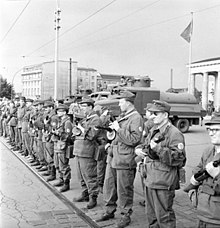

From the first lineups in 1953 to the 1970s
The first units were set up in the second half of 1953. The combat groups were further developed as operational combat groups in the course of 1954 in an evaluation of the uprising of June 17, 1953 . Its official task was initially the fight against saboteurs and other " enemies of socialism " in the GDR, especially as armed security officers. During the Hungarian people's uprising in 1956 , they made public presence. From 1959 the official name was working class combat groups . Their historically most important mission was the participation of 5000 (according to other sources 8000) fighters to secure the border during the construction of the Berlin Wall in 1961, although the actual operational readiness at that time was rather poor.
In 1966/67 the total strength was 181,500 "fighters". The mass was divided between “operational reserves” and “property security forces”. Most of them were organized in battalions of up to four hundred strong. There were also 66 independent motorized "Hundreds" (analogous to companies). These independent units with their better equipment were mainly set up in the border districts to Berlin and West Germany and were directly subordinate to the district operations management of the territorial defense . The battalions and hundreds were mainly formed in large factories or hundreds were put together as territorial units from various factories and institutions.
Turn and peaceful revolution
As early as November 1988, the Leipzig district leadership of the State Security established that the combat groups were no longer politically reliable. During the turning point and peaceful revolution in 1989 , around 3,500 combat group members were supposed to be involved in operations around Republic Day on October 7, 1989 BC. a. activated in Berlin and others put on standby. After the deployment orders were announced, 188 resigned from the combat groups and 146 more refused to serve.
During the Monday demonstrations in 1989 , combat group members were occasionally deployed for security tasks, including in Leipzig , Plauen , Karl-Marx-Stadt (Chemnitz) and Schwerin . The best-known propaganda effort was a letter to the editor in the Leipziger Volkszeitung (at that time the SED daily newspaper ) in which the commander of the combat group hundredths , Hans Geiffert , demanded: “We are ready and willing to effectively protect what has been created by and with our hands in order to counterrevolutionary actions finally and effectively to stop. Gun in hand, if need be! ”The authenticity of this letter to the editor is controversial.
The last person in charge was from 1972 to 1989 Major General of VP Wolfgang Krapp as chief department head of combat groups in the Ministry of the Interior .
After the fall of the Berlin Wall on November 9, 1989 , the combat groups ceased their activities. With the new GDR government Modrow , which initially emerged from the People's Chamber and subsequently from negotiations with the Central Round Table , disarmament was carried out on December 6, 1989 with the order of Interior Minister Lothar Ahrendt . By the end of May 1990, all KG units had been demobilized. The members could keep their personal clothing ( uniform, etc.) privately.
Tasks and structure

According to the documents and teaching content of the Friedrich Engels Military Academy , the district combat forces were intended to be integrated into the structures of the NVA as regular combat units in the event of an emergency. In 1970 battle group units therefore also took part in NVA maneuvers.
They received their operational tasks from the district operations command (chief: 1st secretary of the SED district command, chief of staff: head of the military district command NVA, other members including chief of the district authority of the people's police). Formally, however, they remained directly subordinate to the Security Department in the Central Committee of the SED .
The district combat forces, together with the barracked units of the Ministry of the Interior (MdI) (including VP readiness), were intended to fight armed subversive forces within the GDR. Due to the changing assignment of tasks, you were subject to a variety of organizational changes. The district combat forces and the security units of the district territory were named in the same way as for the district, and directed by the district operations management.
In the combat groups, a distinction was made between combat and security forces. In 1980 there were about 78,500 fighters in the motorized combat forces and about 106,500 fighters in the security forces, plus the reserve, a total strength of about 210,000 fighters was theoretically available. They had different operational and tactical tasks and accordingly also different training content. The reserve of the units should be 10% of the structure and their fighters should step in if the structural forces fail (e.g. prolonged illness or external employment). Women were used as paramedics and in supply.
The independent hundreds consisted of four platoons - three riflemen and one anti-aircraft machine gun platoon, as well as the internal service management team (e.g. paramedics, radio operators, utilities, master-at-arms). The trains consisted of three groups each. The independent platoons of the security forces consisted of three rifle groups and one anti-aircraft machine gun group, as well as the internal service management team. Each rifle group had one LMG and one anti-tank rifle shooter.
With regard to the instructions, the battalions and hundreds were assigned to the combat groups departments at the People's Police District Authorities (BDVP) and District Offices (VPKA). Until 1962, the commanders of the combat group battalions and then for internal service managers and special forces of all units were trained at the VP school in Biesenthal near Berlin. In addition, there was the Central School for Combat Groups (ZSfK) Ernst Thälmann in Schmerwitz for commanders and deputies southwest of Berlin near Wiesenburg / Mark, and since 1974 the Combat Group School Ernst Schneller in Gera for platoon and group leaders. Militia commanders from friendly African countries ( Angola , Mozambique , etc.) have also been trained at the ZSfK Schmerwitz since 1984 .
Combat group formations were used in addition to the civil defense forces of the GDR also in disasters and accidents.
Awards
In addition to the normal state and social awards (activist to Karl Marx Order), these were especially for the combat groups:
- Medal of merit of the fighting groups of the working class in bronze, silver and gold
- Medal for excellent performance in the fighting groups of the working class
- Loyal Service Medal , four levels (10, 15, 20, 25 years)
- Commemorative medal "20 years of working class combat groups"
- Best badge in bronze, silver and gold
- Shooting badges of the combat groups in bronze, silver and gold
Gifts in kind to hundreds of people were also common. For example, on the 20th anniversary of the combat groups in Berlin, all fighters in a hundred were given a wristwatch with a corresponding embossing on the base from Glashütte Uhrenbetriebe (GUB) and, on another occasion, high-quality binoculars from Carl Zeiss Jena .
In 1983 a GDR commemorative coin was issued in honor of the 30th anniversary of the combat groups .
resolution
The disarmament of the combat groups was ordered on December 6, 1989, and their dissolution was then decided on December 14 by the GDR Council of Ministers . The combat group memorial in the Volkspark Prenzlauer Berg was dismantled after German reunification . The peace bell in Dessau was cast in 2000 from the steel of destroyed weapons of the combat groups .
Movie
- Tales of that night , DEFA episode film, 1st episode by Karlheinz Carpentier: Phoenix , 2nd episode by Ulrich Thein: The Trial , 3rd episode Materna by Frank Vogel, director and Werner Bräunig screenplay, 4th episode by Gerhard Klein The great and the little Willi with Erwin Geschonneck as the Hundred Commander Willi Lenz.
literature
- Volker Koop : Army or Leisure Club? The fighting groups of the working class in the GDR. Bouvier, Bonn 1997, ISBN 3-416-02670-5 .
- Torsten Diedrich , Hans Ehlert , Rüdiger Wenzke (eds.): In the service of the party. Handbook of the armed organs of the GDR. Links, Berlin 1998, ISBN 3-86153-160-7 .
- Walter Suess : State security at the end. Why the powerful did not succeed in preventing a revolution in 1989 (= The Federal Commissioner for the Records of the State Security Service of the Former German Democratic Republic. Analyzes and Documents. Volume 15). Christian Links, Berlin 1999 ISBN 3-86153-181-X .
- Clemens Heitmann : Protect and Help? Air raid protection and civil defense in the GDR 1955 to 1989/90 (= military history of the GDR , volume 12). Links, Berlin 2006, ISBN 3-86153-400-2 (also: Potsdam, Universität, Dissertation, 2005).
- New rifles . In: Der Spiegel . No. 31 , 1963, pp. 39 ( online ).
Web links
- Information ( Memento of November 21, 2007 in the Internet Archive )
- Tilmann Siebeneichner: Proletarian virtuosos? - Contradictions and distortions in the elite politics of the SED using the example of the fighting groups of the working class (PDF)
Individual evidence
- ↑ after C. Heitmann, Schützen und Helfen? Air raid protection and civil defense in the GDR from 1955 to 1989/90 Page 222, the KG were strictly subordinate to the SED .
- ↑ Volker Koop: Army or Leisure Club? The fighting groups of the working class in the GDR. P. 94.
- ↑ Torsten Diedrich, Hans Ehlert, Rüdiger Wenzke: In the service of the party: Handbook of the armed organs of the GDR. Pp. 307, 308.
- ^ Gilbert Jacoby: 1989/90: The "Peaceful Revolution" in the GDR . epubli, 2011, ISBN 978-3-8442-0978-5 , p. 86 f.
- ^ Walter Suess: State Security at the End. Why the powerful did not succeed in preventing a revolution in 1989. Ch. Links Verlag, 1999, ISBN 978-3-86153-181-4 , p. 369 ( limited preview in Google book search).
- ↑ Working people in the district demand: no longer tolerate public hostility. In: Leipziger Volkszeitung , October 6, 1989, p. 2.
- ↑ Special editions & award watches from the Glashütte watch manufacturer VEB . glashuetteuhren.de. Retrieved June 2, 2019.
- ^ Walter Suess: State Security at the End. Why the powerful did not succeed in preventing a revolution in 1989. Ch. Links Verlag, 1999, ISBN 978-3-86153-181-4 , p. 532 ( limited preview in Google book search).
